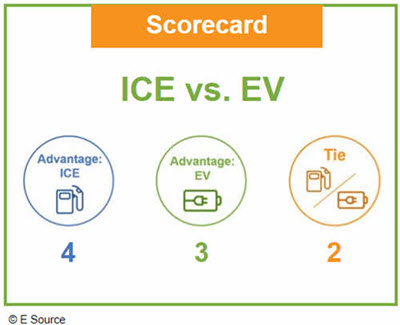EVs aren’t that great ... or are they?
Sure, those in the electric vehicle (EV) business love their EVs. Electric utilities and EV owners and enthusiasts are all big fans. But are these cars really that great compared to the internal combustion engine (ICE) car we’ve been used to all our lives?
People buy things when they’re better than the status quo. And sometimes the new things need to be far better. Let’s look at three technologies that moved away from the status quo and created massive shifts in functionality. They subsequently took over the market, which is what fans of EVs are hoping their favorite type of vehicle will do.
Air-conditioning (AC). The prior solutions were using fans, opening windows, and sleeping outside. AC transformed our indoor environments and comfort, our ability to work more productively, and even our land-use patterns. Cities like Phoenix and Dallas are thriving thanks to this technology.
Gas-powered automobile. The prior solution was the horse-drawn buggy. The changes in utility couldn’t be more profound. Speed, simplicity, distance, and power were all dramatically improved. And the automobile significantly changed our land-use and housing patterns.
The internet. This is the change almost all of us experienced firsthand. It changed everything we do—sharing information, doing research, planning travel, getting entertainment and news, interacting socially, and more. It didn’t take long to gain worldwide popularity.
With the stories of these technologies in mind, I asked myself, What’s so great about EVs? Which attributes are better, and are they enough to transform car ownership?
What makes a car so great, anyway?
An EV’s basic function, getting people from point A to point B, is pretty much the same as an ICE vehicle’s. So I did some research with the help of my LinkedIn connections. I asked them to list the five most important attributes they and their family members look for in a car, not including environmental issues. The question wasn’t about EVs. It was simply about personal transportation choices. Here’s a summary of the top attributes from the 25 respondents.
Top-tier attributes:
- Value. Low cost of ownership, a purchase price that isn’t too high, and being a good value for the money paid
- Roominess. Enough room for the stuff needed for trips and everyday tasks—and multiple family members

Second-tier attributes:
- Sexy. Styling, interior amenities, colors, and the overall cool factor
- Handling. The way the car handles under different driving and weather conditions, speed, and acceleration
- Safety. This attribute ranked fairly low because, I think, people expect all cars to be safe these days
- Tech. Autonomous driving, cameras, sound systems, and other technologies
- Comfort. All aspects of comfort, including seat comfort and how smooth the ride is
- All-wheel drive (AWD). Becoming more important for everyone, but especially for some of my colleagues in Colorado
Where can EVs compete with ICE cars?
Taking everything that car owners think about when purchasing their next vehicle into consideration, we can start to compare status quo ICE vehicles to EVs to see where (and if) EVs have an advantage. Keep in mind that I removed the environmental benefit as an attribute because my colleagues place a very high value on that attribute compared to the general population. We’ll come back to that later.
Value. EVs will eventually be a better value if sales numbers go up and manufacturing costs come down. For now, they’re expensive to buy compared to an ICE vehicle. Most people aren’t aware of the total cost of EV ownership, and many don’t know about the potential tax credits available to them. Advantage: ICE
Roominess. EVs don’t have any advantage in the roominess category. And there are few EV options in the crossover and SUV category, which is currently the most popular ICE model. Advantage: ICE
For the top-two attributes, ICE vehicles definitely have the advantage. But we aren’t not done yet. Let’s consider the secondary attributes.
Sexiness. EVs are the new kid in town, and Tesla dominates. That’s pretty sexy. Advantage: EV
ICE cars have the advantage

Handling. Most people who have never driven an EV have no idea how well they handle. But once they have … Advantage: EV
Safety. Recent news, like the CNBC article GM warns some Bolt EV owners: Don’t park them inside or charge them unattended overnight, isn’t helping the EV cause, but ICE vehicles have issues too. Advantage: Tie
Tech. Although Tesla’s technology is generally seen as being superior, this category is too close to call. Advantage: Tie
Comfort. Due to the wider range of model options, ICE vehicles eke out the advantage in comfort. Advantage: ICE
AWD. Very few EV models offer AWD. Would adding that feature be the trick to winning over more drivers who live in areas prone to treacherous weather? Advantage: ICE
Environment. EVs are the clear winner here, and they’ll stay in the lead as the grid is decarbonized. While not everyone values the environmental benefits of EVs equally, they’re a dominant factor for many. I asked our respondents to not include environmental impact on their top-features list, but we’re including it here and adding it to the scorecard. Advantage: EV
We also have to tackle the elephant in the room: fueling. Our research shows that a high percentage of the population thinks that fueling an EV is either difficult or a total mystery. This simple fact keeps many people from considering an EV at all. The good news is that we can help overcome that barrier with smart messaging.
How utilities, governments, and nonprofits can get drivers on board with EVs
My conclusion from this analysis is that we must identify the attributes where EVs outshine ICE vehicles, find the people who care most about those attributes, and encourage them to buy their first EV. These are the clear advantages of EVs:
- Environmental benefits. In almost all parts of the US and Canada, EVs are better for the environment (carbon and local pollution) now and will be even more so as we add renewables to the grid.
- Handling. Getting behind the wheel of an EV can be a transformation, and just being a passenger can pique one’s interest. My Nissan Leaf is by far the zippiest car I’ve ever owned.
- Sexy new tech. Usually people like new technology and want the latest and greatest. However, legacy car brands carry a lot of weight, and change is hard.
We’re leading a marketing campaign in partnership with Boulder County, Colorado, that emphasizes how easy it is to charge at home—even easier than fueling an ICE vehicle. Our industry hasn’t done itself a favor by emphasizing the need for public charging infrastructure and limitations on EV range. These messages focus peoples’ attention on what they should be afraid of. Instead, we recommend several simple, key messages to overcome barriers to buying an EV:
- Charging at home is easy
- There’s an EV that fits your lifestyle
- There are rebates and tax credits available that make an EV affordable
- The public charging network is growing and becoming simple to use with smartphone apps, so you’ll never be stranded
These messages addressing barriers must be accompanied by motivational messaging, which follows the top attributes uncovered in my LinkedIn polling project:
- EVs are the fastest way to lower your environmental footprint
- EVs are the most fun car you’ll ever drive
- EVs are the wave of the future. Why are you driving 20th-century technology?
Utilities, governments, and nonprofits can play a pivotal role in helping accelerate the market for EVs. Legacy car companies aren’t going to step up until they see a much larger market, which is years away, so it’s up to utilities and governments to push the envelope on marketing instead of only investing in infrastructure. Having a nuanced understanding of why someone would or wouldn’t want to purchase an EV is essential. Ultimately, we can’t just tell people that EVs are better because we like them so much. We must focus on the attributes drivers care about most to win them over.
